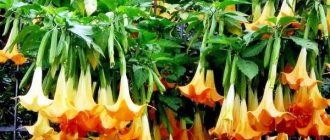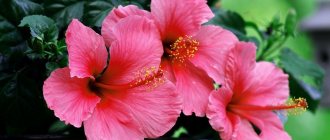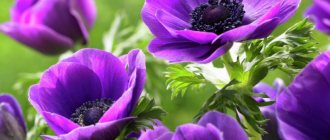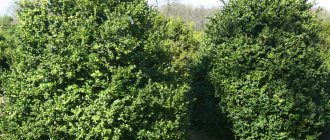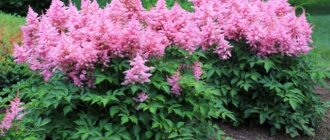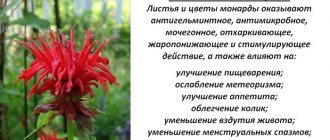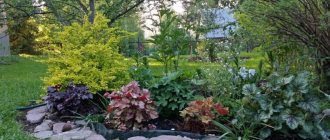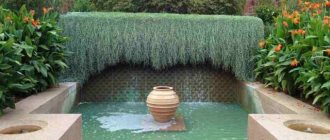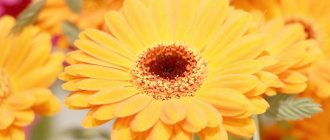Representatives of the Cereals family (Poaceae) have become regulars in gardens, home areas, and park areas. Herbaceous ornamental perennials, contrasting with flowering plants, give the area an original, unusual look. One of them is Haconechloa or Haconechloa from the island of Honshu, where it grows on the slopes of mountains and cliffs. In temperate climates, it adapts well to conditions and tolerates cold winters without loss.
- Features of culture
- Varieties for landscape design
- Growing - conditions, care
- Reproduction methods
- Hakonechloa in landscape design
Features of culture
Cereals, as a rule, are grown for leaves that are unusual in shape and color, different from other plants. The attractiveness of Hakonechloa lies precisely in this feature - its leaves, narrow and long, with a clearly defined central vein, are colored in various shades of green, yellow, and there are varieties with variegated leaves. Thin long (35-50 cm) stems bend under the weight of the foliage, forming a fluffy bush about 0.5 m in diameter and the same height.
Because of the drooping stems, the plant received a second name - “weeping (weeping) grass.” People sometimes call it Japanese reed, Japanese forest grass.
The long rhizome takes roots firmly and grows slowly, which is a distinctive feature of the culture. The shoots, having appeared, also grow very slowly and all in one direction, so the bush gradually becomes like a cascade of stems and leaves. It will take at least five years to reach the size of an adult plant. Another distinctive feature of the leaves is that they change color when the temperature drops.
Each variety has its own flowering period - it can occur in July or August, sometimes in early autumn. The spike-shaped inflorescence protruding above the surface of the foliage consists of 5-10 small white inconspicuous flowers, which become orange or bronze by autumn. After flowering, the inflorescence does not disturb the decorative appearance of the bush - the elongated grain-like fruits give it some airiness and originality.
The ability to tolerate low temperatures lies in the structure of the plant - renewal buds, covered with scales, are protected during dry and cold periods by fallen leaves, plant debris, and a layer of snow, since they are located at the soil level or just above its surface. Perennial hemicryptophytes, for example, some cereals, buttercup, and dandelion, have this feature.
Varieties for landscape design
The genus Haconechloa is monotypic, since it has only one species - Haconechloa macra (H. large). Interestingly, in some sources it is called hakonechloa lean. The species began to be cultivated in 1930, and now new interesting, more decorative and adapted to the climate of mid-latitude varieties have been developed:
- H. macra Aureola (H. large “Aureola”) is one of the most decorative and frost-resistant varieties with bright golden-yellow leaves, along the central vein of which a green stripe stands out; in the sun the color is brighter, more saturated; in partial shade the leaf becomes uniform yellowish color;
- H. macra Aurea (H. large "Aurea") - the height of the bush is no more than 40 cm, there is a dark green stripe running down the center of the ocher-yellow leaf, flowering begins in late summer;
- H. macra Albo-aurea (H. large “Albo-aurea”) - in bright light the leaf becomes brown, in shaded areas it is yellowish-golden, with rare white stripes, the stems are reddish-brown;
- H. macra Fubuki (H. large "Fubuki") - an original low-growing bush with grayish-white leaves and a green narrow stripe in the center, grown in partial shade, because it burns in the sun;
- H. macra All Gold (H. large "Ol Gold") - medium-high (40 cm) variety, golden-yellow leaves, withstands frosts down to -23 ° C;
- H. macra Stripe it rich (H. large “Stripe it Rich”) - a new generation variety, high frost resistance - up to -28 ° C, yellowish-green leaf, with a central white stripe, flowers appear in August;
- H. macra Naomi (H. large "Naomi") - stems grow up to 35-40 cm in height, blooms in mid-late summer, green leaves become burgundy-purple by autumn; high frost resistance - withstands frosts down to -23 ° C;
- H. macra Nicolas (H. large "Nicholas") - is distinguished by the elegant shape of the bush (height about 35 cm) and reddish-orange, with a golden tint, leaves.
Growing - conditions, care
There is always a place for an unpretentious perennial crop in a garden plot or local area - hakonechloa will grow in both sun and partial shade. But in the sun, its successful development depends on regular watering; if this is not possible, then it is better to plant it in partial shade to prevent the soil from drying out. The place must be protected from draft winds.
It prefers slightly acidic or neutral soil, fertile, loose, rich in organic matter - on dry sandy and heavy soils it practically stops developing. When planting in a hole, be sure to pour a drainage layer so that moisture does not stagnate at the roots. If the groundwater is high, then you can build an embankment ridge or flowerbed.
Care consists of regular watering, the volume of which depends on weather conditions. The main thing is that the soil should be moist, not soggy. On fertile lands, fertilizing is not needed, but if there is a lack of nutrients, use complex fertilizers for ornamental foliage plants in solution or in dry form, scattering them under the bush before watering, 10-15 cm from the center.
Most varieties of Hakonechloa are frost-resistant, but it is better to mulch the soil to reduce the risks. If the winters are harsh, then you can cover the bush completely, covering it with leaves, dry grass, and branches.
It is recommended to carry out pruning in early spring - at a height of 6-10 cm, cut off the dried above-ground part. You should not cut lower - you can damage the growth buds, which are not always noticeable.
Reproduction methods
The most convenient way to get clearings with beautiful elegant herbaceous bushes in your area is to divide an adult plant into several parts. This should be done early in the spring, when the growing season has just begun.
To do this, dig the bush around the circumference, take it out along with the soil and carefully clean the roots from it. On the rhizome, in the upper part, thickenings like thorns are clearly visible - these are buds from which a new shoot will begin to grow. The root is divided into segments so that each has a bud. The cuttings are planted in prepared holes with a drainage layer and watered.
The seed method for propagation is rarely used - complete ripening of the seeds does not always occur and there is a possibility that varietal characteristics will not be inherited. But if you manage to purchase seeds, they are sown in early spring in loose, moist, nutritious soil, using a low container.
There is no need to cover the seeds with soil - just sprinkle a little sand on top. The container is covered with a lid, film and placed in a cool room with diffused light. Care consists of ventilating the mini-greenhouse and moistening the soil. As soon as shoots appear, remove the lid. Seedlings are planted in open ground at the end of spring, having first built a shelter from spunbond or placed a cut plastic bottle over each bush.
Reproduction of Hakonechloa
Since Hakonechloa is a slow grower, there is no need to worry about it taking over the garden. When it is large enough to divide, you can do this either in the spring or fall. Hakonechloa should be divided after it has begun new growth in the spring, but no later than the end of June, since its rhizomes form roots soon after expansion, if not simultaneously. The problem is that the long growths have no roots, as the plant grows and divides much like a spider's web, expanding the rhizomes throughout the summer, producing foliage, but the roots on these plants do not appear until the following spring. The plant begins to expand new rhizomes and there is a 2 week window when it can be divided into many small plants. Since new growth is small, only 2 or 3 cm, at planting add a fertilizer mix, combined 50/50 with compost, to stimulate root growth, which is necessary at this stage as Hakonechloa are slow to establish, even during their most aggressive burst growth. Place each young plant in 15 cm pots, paying close attention to planting depth. It is important to keep the new growth and roots at the same depth as when growing the mother plant outdoors. After this, place the pots in a greenhouse for a week or two, as full sun will damage new growth. Seedlings should spend time under shade cloth or outdoors in a protected, cool location for 6-8 weeks to allow the roots to fill the container before planting in the garden.
Propagation by seeds
The Hakonechloa seed is quite tiny and difficult to germinate, so it's best not to try to grow it this way, but it is by far the most economical way to grow slow-growing plants. Seeds of any ornamental grass should be placed in a container filled with moistened planting mixture. The seeds need a thin layer of soil or sand on top for good germination. The clear plastic covering maintains a high level of humidity, allowing the seeds to germinate. One or two plants in a container prevents plants from competing for nutrients in the soil. Before planting Hakonechloa outdoors, leave the seedlings in the shade for a few hours each day to acclimatize. Plant young hakonechloa seedlings in a hole that is twice the size of the root ball. Keep young plants well watered for the first few weeks.
Hakonechloa in landscape design
Against the background of familiar greenery, perennials with unusual foliage colors look very decorative. Single inclusions of contrasting lush bushes will decorate any corner: a lawn, planting trees and flowering bushes, a flower garden, a front garden, and in a group they look great in the foreground of tall bushes, coniferous trees, and hedges.
The leaves retain their bright color almost until winter, which is important when creating compositions from deciduous perennials.
- curb along the paths;
- edging flower beds, compositions;
- single plantings in the rock garden;
- Japanese style garden element;
- design of the reservoir;
- compositions with other cereals;
- a carpet of any shape or a small lawn of low-growing varieties that can be mowed;
- designing a site under the canopy of trees, alpine slides, rockeries.
Where can you buy exotic crops?
If you wish, you can find cereal crops in nurseries, garden centers, and online stores:
- Online store "5 plus"
- Agro,
- Moscow nursery of ornamental garden plants,
- Online store “Rare perennials from Selina-M”,
- Garden.
Attention! Some stores only carry a few varieties of Hakonechloa. Therefore, if you need a specific plant, you will have to search. Prices vary from 250 to 500 rubles per bush. There are copies whose price reaches 1,500 rubles.
Hakonechloa is an unusual plant that will decorate any garden. To do this, it is not at all necessary to create it in the Japanese style. This plant will look advantageous in any compositions you create.
Other interesting herbs for the garden:
- feather grass,
- micanthus,
- Emperor.
Japanese grass Hakonechloa: varieties and growing conditions
- Flowering period: July August
- Height: 30-50 cm
- perennial
- Winters
- Shade-loving
- Moisture-loving
- Color: green yellow gold, purple white
Hakonechloa (lat. Hakonechloa) or Hakonechloa is a genus of herbaceous plants belonging to the family Cereals (lat. Poaceae). Members of this genus are often called Japanese forest grass. Hakonekhloa appeared in our gardens along with the fashion for Japanese style. In the wild, this grass grows on rocks and cliffs on the island of Honshu, so it does very well in a temperate climate. The discovery of Hakonechloa belongs to the founder of Japanese botany, Makino Tomitaro.
How to grow Hakonechloa
Japanese forest grass grows in any moist, well-drained soil with plenty of humus and other organic matter. Amend the soil with compost or peat moss if you feel your conditions are less than ideal.
- Mulch. Spreading mulch around plants will help keep the soil cool and moist throughout the summer and will also discourage weed growth. In cold winter regions, spreading mulch will help prevent Hakonechloa from freezing.
- Fertilizer. Organic mulch provides all the nutrition the plant needs. If you fertilize, do it in the spring immediately after the first new growth appears, and then leave the feed for the rest of the season.
- Light. Japanese forest grass prefers partial shade, such as is found in forested areas. In cooler climates, it can tolerate locations with more sun.
- Watering. Hakonechloa requires frequent watering and moist soil. This plant is not suitable for dry conditions.
- Temperature and humidity. Cool, moist conditions are preferred, similar to the low mountain forests where the plant grows naturally. Extreme heat or cold can kill Hakonechloa.
- Care. Hakonechloa is an unpretentious plant. Remove dead foliage from the previous season's growth any time from late fall to early spring. Or you can leave the dead foliage alone until spring to provide winter protection to the plant. There are no serious diseases or pests that plague Japanese forest grass. The leaves may burn in hot weather, but new ones will grow back easily.
Description
Hakonechloa is a perennial herb with soft, long weeping leaves. Their linear shape resembles bamboo leaves. The height of adult plants is from 35 to 50 cm, the diameter of the bush is about 50 cm. Plants grow slowly: shoots are periodically thrown out, from which new shoots appear, growth occurs in one direction. This creates a shape that resembles a kind of cascade. In nature, Hakonechloa grows in dense groups.
The plant has an elongated stem, 35-50 cm. Flowering usually occurs in July, August or September. The time of its onset depends on the variety. The inflorescence is a spike with 5-10 unremarkable and small white flowers. The fruit is an elongated grain. Hakonechloa reacts to air temperature: when it decreases, the color of the leaves becomes brighter.
Hakonechloa leaves and flowers
Plants belong to hemicryptophytes. Their renewal buds, from which shoots appear, remain at ground level or slightly above during unfavorable periods of the year. The buds are protected by scales. They are protected from freezing by fallen leaves and snow cover.
Types and varieties
Bergenia and hakonechloa.
The only representative of the family is the species Hakonechloa major . A low, dense bush (up to 50cm) grows slowly and somewhat unusually: young shoots grow in one direction, due to which a cascade of elongated, lanceolate leaves is formed.
It is a perennial plant whose foliage resembles bamboo. All summer it is green, by autumn it turns pink, and bunches of spikelets grow on top of the bush. Hakonechloa has drooping leaves, which is why it became known as “weeping grass.”
Garden crops are represented by a number of varieties bred by breeders since 1930:
- Albo-aurea: The foliage on the stems grows in a circle (alternately) with a red-brown hue. The bush is golden-yellow in color, which makes the crop stand out against the background of green foliage. In bright light the plant turns brown.
- Aureola: has long, golden leaves with green stripes. The color of the foliage directly depends on the temperature. When they change, she blushes. In the light it turns yellow, and in the shade it acquires inconspicuous shades.
- Albo-variegata: drooping green leaves with white stripes. By autumn the bush turns red and seems unreal.
- All Gold: This variety is similar to Aureola, but the bush is completely golden, without any shades. It does not change its color.
- Fubuki: miniature variety. The leaves are white with a green border in the center. It burns easily in the light and feels great in the shade.
- Naomi: bush up to 40cm. Green foliage turns burgundy-purple in autumn. In July-August it produces spikelets of inflorescences, which are inconspicuous, like those of other members of the family.
- Stripe it rich: a recently developed variety. The yellow foliage has an unusual white stripe in the center. Good winter hardiness. Flowering occurs in August.
Varieties of this crop are difficult to find on sale, which is due to slow growth, reproduction characteristics and low popularity.
Important to know: Hakonechloa has renewal buds from which shoots grow. The buds are stored in unfavorable conditions at ground level. They are covered with scales. They are protected from freezing by leaf litter and snow cover.
Varietal diversity
The genus Hakonechloa is monotypic, consisting of one species, H. macra (lat. H. macra). Since Hakonechloa is unpretentious and very decorative, since 1930 (the year of its discovery) botanists have been working on developing new varieties. Some varieties have single-color foliage, while others have two-color foliage. Today the most popular and beautiful are:
H. large "Aurea" (lat. H. macra 'Aurea') grows up to 35-40 cm, blooms in August. The leaves are ocher-yellow in color and have a dark green stripe in the middle.
H. large "Aureola" (lat. H. macra 'Aureola') is the most common variety. The leaves are golden in color with a thin green stripe running along the central vein. Plants look more impressive in sunny places: the color of the leaves becomes brighter. Of all the varieties, “Aureola” is considered the most frost-resistant.
H. large "Albo-aurea" (lat. H. macra 'Albo-aurea') is a variety whose leaves turn brown in strong light, so it is better to grow in shade or partial shade. Stems are red-brown. The foliage is a warm yellow-golden hue with a small splash of white stripes.
H. large 'Nicholas' (H. macra 'Nicolas')
H. macra 'All Gold' (lat. H. macra 'All Gold') is a variety with golden foliage that blooms in July-August. Plants grow up to 40 cm, bush span 50 cm. Frost resistance zone 5.
H. large "Albo-striata" (lat. H. macra 'Albo-striata') has green foliage with three white-yellow longitudinal stripes: in the middle and along the edges.
H. large "Naomi" (lat. H. macra 'Naomi') grows up to 40 cm, the diameter of the bush is 50 cm. The foliage is green, becoming purple-burgundy in color closer to autumn. Flowering occurs in July-August. Winter hardiness zone 5.
H. macra 'Stripe it rich' is one of the new varieties, distinguished by beautiful yellow foliage with a longitudinal white stripe in the center. Winter hardiness zone 4. Flowering occurs in August. Plant height up to 40 cm.
H. macra 'Nicolas' (lat. H. macra 'Nicolas') is an elegant plant with solid orange-red-gold leaves. Grows up to 35-40 cm.
H. large "Fubuki" (lat. H. macra 'Fubuki') is one of the smallest varieties. A distinctive feature is the practical white leaves with a wide green stripe in the middle. Such plants can get sunburned, so they are planted mainly in the shade.
Japanese reed Hakonechloya
Hakonechloa, or Japanese reed, is incredibly beautiful in natural style flower beds. This plant, up to 40 cm tall, with gracefully arching yellow-green stems, enlivens the shaded corners of the garden.
Japanese reed prefers shady places with fertile soil. The stems die off in winter, but grow back every spring.
Hakonechloa is a true ornamental treasure, this gorgeous perennial looking like a tuft of fine golden leaves brings a golden glow to shady corners of the garden.
An outlandish exotic plant that easily adapts to cultivation and is a completely unpretentious plant.
A mass of long lanceolate leaves spreads sadly in a dense clump, which was the source of another name - “weeping grass”.
It grows very slowly, hakonechloa seems to throw out shoots that become overgrown with leaves and form a cascade of clumps.
During the winter, the above-ground parts of the Japanese reed die off completely and the bush completely recovers each spring, usually growing slightly larger than the previous year.
The leaves of the base plant resemble elongated bamboo leaves, dark green, turning pink in autumn, but today the predominantly golden forms of Japanese reed, which are distinguished by their yellow, very light leaf color, are actively used.
Hakonechloa blooms at the end of summer, producing yellowish sparse spikelets slightly higher than the clump itself. The most popular varieties of Japanese reed " Aureola " (Aureola) is the most common and most frost-resistant form of Hakonechloa.
A charming and graceful plant with a golden color, thin and very long leaves with green stripes.
In regions with mild winters, Japanese reed is bright yellow, in regions with harsh winters it is greener.
In spring and autumn the leaves turn red. This form of Japanese reed grows only in partial shade, because in deep shade it loses its bright color, and in the sun it fades.
An all-gold alternative to this form is All Gold. " Alba Aurea " (Alba Aurea) is a golden-spotted form of Hakonechloa, which is distinguished by an alternate arrangement of leaves, a reddish color of the stems and a golden hue of foliage with rare green stripes.
This form of Japanese reed in autumn, in the bright sun, leaves become covered with pink and scarlet spots, but this does not mean that the plant is better grown in illuminated areas: the leaves of such specimens become brown and lose their attractiveness.
The original version of this form is presented in the Albo Striata variety, the leaves of which grow almost horizontally and are colored golden-green, turning white in autumn. The variegated green and white color comes in the form of " Variegata ", whose long green leaves are covered with white stripes and turn crimson in autumn. Japanese reed grown in both sunny and shady areas, although the largest clumps and beautiful colors are observed in plants that grow in partial shade.
In full sun, Japanese cane requires high soil moisture.
Hakonechloa should not be grown in windy areas.
The soil for it must be fertile. It is necessary to add humus to it, and to lay small drainage in the planting holes.
When grown in partial shade, the plant is undemanding to soil moisture, but in dry weather it is better to water it moderately. In winter, the soil around the hakonechloa is mulched.
In spring, dead leaves, if they remain on the plant, are cut off completely. Japanese reed is propagated by dividing the bush. In landscape design, hakonechloa is planted in flower beds and mixborders imitating natural plantings or used to highlight dark compositions.
Japanese reed also looks great against the background of gravel paths, framed by decorative soils, against the background of a lawn, in rockeries, as a solo decorative foliage plant, in thematic ensembles of Japanese or oriental style, in classic flower beds, ridges and even as a tub crop.
The border made of Japanese reed looks original, separating the path, curtains growing on slopes, the banks of a pond or streams.
Ideal partners for hakonechloa are considered to be funkia, bergenia, low ferns and brunnera, and all dark-leaved perennials.
Photo gallery of species
Growing and care
Many varieties have a frost resistance zone of 4-5; plants tolerate winters with temperatures down to – 30 °C. In the case of slowly growing hakonechloa, it is better not to take risks: mulch the soil around it, and in more northern regions, cover it during the cold season.
Design of a garden corner with a stream
Plant plants in places protected from drafts. Hakonechloa tolerates shade well. In dry weather it needs abundant watering, but it tolerates short-term droughts well. If you organize very good watering, then it is possible to grow and care for Hakonechloa in a sunny place. Herbs love humus-rich soils with good drainage. They are not demanding in terms of care and do not suffer from any diseases.
Hakonechloa in late autumn
In early spring, pruning is necessary: last year's dead foliage is cut off. The procedure requires precision and sharp instruments. Plants are pruned at a height of 6 to 10 cm above the ground. You cannot cut below, so as not to be left without growth (renewal) buds, which are not always visible.
Basic rules of cultivation and care
The cereal crop is quite unpretentious in care, so every gardener can grow it:
- the most suitable place is warm and protected from the wind;
- prefers drained soils rich in humus;
- Regular watering is necessary, especially if the plant is in a sunny place; but a short drought is not terrible for her;
- In the spring, before growth begins, pruning is carried out: last year's foliage is removed. It is carried out carefully using sharp instruments. Old foliage must be removed before new foliage grows;
- in winter, the soil around the plant is mulched so that the renewal buds do not freeze;
- Hakonechloa does not require special care and is not affected by diseases.
Important to know: Old leaves are cut off at a level of 6-10cm. from the surface of the earth. If you cut lower, you can destroy the buds, which are usually hard to see.
Reproduction
Plants are propagated vegetatively: by dividing the bush at the beginning of the growing season in early spring. At the top of the rhizome you can see buds that look like thorns, from which shoots emerge. To propagate Hakonechloa, it is necessary to separate such a bud from a rhizome segment. They do this extremely carefully. It is often not recommended to propagate the plant in this way.
Hakonechloa and decorative onions
You can try growing hakonechloa from seeds, but quite often in our climate zones they do not ripen. If you can find seed, then sow it in a pot, lightly sprinkle it with sand, cover it with cellophane and place it in a cool place. It would be best to create conditions close to the natural growing environment. It is worth remembering that with this method of propagation, varietal characteristics may not be preserved, for example, the most valuable - the color of the foliage. The sprouts are planted at the end of spring in a shaded place and the hakonechloa planting is covered with a mini greenhouse.
Joint planting: H. macra 'Aureola', Acer 'Emperor I' and Persicaria 'Painter's Palette'
Reproduction: basic methods
Hakonechloa is propagated vegetatively . This operation is carried out at the beginning of the growing season. On the rhizome, in its upper part, there are renewal buds. They resemble sharp thorns and shoots form from them.
Such a bud is separated from the main clump with a rhizome segment. Do everything carefully, without injuring the plant. It is not recommended to use this method often because the bush grows slowly.
It is possible to obtain hakonechloa from seeds, but they do not always ripen. If you have seed, then it is sown in a small container, covered and left in a cool place. The emerging sprouts are planted in a shaded corner of the garden, covered with a mini-greenhouse.
Attention! With this propagation method, the varietal qualities of the plant are not always preserved. For example, such a quality as the color of foliage, for which hakonechloa is grown.
Decorative use
Japanese forest grass is used very widely in landscape design. Firstly, it is indispensable for creating Japanese-style gardens; it combines organically with bamboo, miscanthus and other plants native to the Far East and Japan. Quite often, it is used to design approaches to natural and artificial reservoirs.
An unpretentious grass with an interesting shape of bushes, somewhat reminiscent of gentle waterfalls, is actively used to decorate steps, rocky slopes and the space between paths. It can also be used to effectively cover tree holes.
In flowerbeds and mixborders they are grown both individually and in group plantings. Hakonechloa makes a great background plant. This unpretentious grass goes well with cloves, armeria, geranium, astilbe, and hosta. An excellent combination is obtained with allium, the flowering arrows of which beautifully rise above the flowerbed. Suitable for decorating low borders. What’s good about Hakonechloa is that its decorative effect lasts almost until winter.
Growing in a container
It is quite popular to plant hakonchloa on alpine hills and rockeries. Such areas are similar to its natural environment
Companions and use of Hakonechloa in the landscape
This vigorous broadleaf grass is similar in many ways to dwarf bamboo. It is used as a border, container, and ground cover plant. It looks great in mass plantings, rock gardens, urban and rural landscapes. The golden leaves of the grass will brighten partially shaded or dark gardens. Hakonechloa makes a great accent plant near ponds or at the base of gazebos.
Create attractive combinations by planting Hakonechloa shrubs near green spotted pulmonaria, green or silver brunner. Create a color echo by pairing Hakonechloa with other golden foliage or differently shaped plants such as hosta 'Sum and Substanc', yellow Dicentra spectabilis 'Gold Heart' or variegated hostas to highlight the golden or cream variations of the herb. Use gold or variegated shapes as a backdrop for dark-colored flowers, such as deep purple "Queen of Night" tulips or Astilbe "Burgundy." Light green and gold leaves help brighten dark areas, and they pair well with blue-flowered plants such as Himalayan birch (Betula utilis); hydrangea (Hydrangea macrophylla); rhododendron, soft acanthus.
This grass is a wonderful accent next to water gardens, near a path or at the base of a tree or post, and looks great among large rocks in a rock garden. Try placing the hakonechloa on top of a wall or deck where it can cascade over the edge. This is a great addition to an Asian style garden or to add a tropical touch to your garden.
Join our Facebook group
Hakonechloa in garden design
Cereal gardens are one of the fashionable trends in landscape design. By placing them on your site, you will fill it with movement and the music of ears of corn swaying in the wind. Grasses naturally fit into a wide variety of garden themes and styles.
Hakonehloi is native to the humid base of Japan, Honshu. The graceful, arched stems of this grass rise in a free cascade to a height of up to 60 cm. For its appearance, hakonechloa received the name “weeping grass”. It has light green foliage, reminiscent of bamboo, which turns warm pink in the fall. At the end of summer, delicate, inconspicuous tufts of spikelets appear between the leaves. Due to its slow reproduction rate, it still remains exotic in our gardens.
Hakonechloa in garden design.
At the prestigious Chelsea Flowers Show 2004, a composition made from hakonechloa received a gold medal. The cereal was planted in three bushes of different heights in the shape of an asymmetrical triangle on a vast meadow of moss. A path of flat stepping stones ran through the moss carpet in a draft; nearby, several single ostrich ferns looked picturesque.
Hakonechloa in landscape design.
Hakonechloa, description, types, photos, growing conditions, application
Hakonehloi native to the humid base of Japan, Honshu. The graceful, arched stems of this cereal rise in a free cascade to a height of up to 60 cm.
Description
For its appearance, Hakonechloa received the name “weeping grass”. It has light green foliage, reminiscent of bamboo, which turns warm pink in the fall. At the end of summer, delicate, inconspicuous tufts of spikelets appear between the leaves. Due to its slow reproduction rate, it still remains exotic in our gardens.
Hakonekloya can be used anywhere. It is low enough to frame a flower bed or plant near a pond, and is attractive enough on its own to be used in a perennial border.
It makes a great container plant, maintaining its shape for many years and softening the shape of the pot as it cascades over the edges.
Kinds
NEW Hakonechloa macra 'All Gold'. One of the most graceful members of the grass family comes from Japan and deserves a special place in every shady garden.
The height of the bush is 35-40 cm. It grows slowly and in a characteristic way: the compact bush throws out shoots, which, growing in one direction, form an interesting cascade. It has foliage that looks like bamboo. Due to its unusual appearance it was called “weeping grass”. At the end of summer, spikelets of spikelets appear just above the tuft of grass.
All Gold is a colorful, graceful herb with long, slender golden leaves. Temperature greatly influences foliage color. In warm regions, the yellow color is more pronounced.
Temperature changes in spring and autumn often cause slight redness in the leaves. The most frost-resistant variety. Zone 4(5)-9. Location: warm, protected from cold winds, semi-shaded place. In dry weather, watering is necessary, but it tolerates short periods of drought well. Mulching is required for the winter. Indispensable for a Japanese garden.
In the rather small community of ornamental grasses, new products appear infrequently. And if some exotic thing like dwarf bamboo appears, then in reality it will turn out to be sissy and picky. Not at all like hakonechloa, or Japanese forest grass. With its hardiness, it competes with our native cereals and certainly surpasses the varieties of miscanthus, popular among European designers.
With the craze for the Japanese garden, many characteristic plants came to Europe. It is appropriate to note that small Japan is not inferior to endless Russia in terms of plant species diversity, and its islands are located in three climatic zones: temperate, subtropical and tropical.
At the same time, only a small fraction of all this wealth is traditionally used in the Japanese garden. The Japanese avoid overly bright and flowery plants, which we Europeans adore so much, and most of all they value naturalness. The unique beauty of a Japanese garden comes, first of all, from the thoughtfulness of details and impeccable grooming.
Therefore, Japanese designers most often choose those ornamental plants that are easy to care for, unpretentious and never lose their attractiveness.
Hakonechloa macra, along with bamboo, are two of the most popular cereals in the Japanese garden. But if bamboo is a taboo topic for the center of Russia, then Hakonechloa turned out to be an extremely hardy species, perhaps it will have a tough time even in our north. Among herbaceous plants, the phenomenon of such adaptability is not uncommon. Let us at least remember the natives of Japan: hosta, pachysandra, astilbe.
Growing conditions
Firstly, Hakonechloa is represented in gardens not as a natural species, but as several decorative varieties. In our country, the most interesting of them, “Aureola,” is most famous and widespread, forming spreading rosettes of linear white-variegated leaves.
The usual height of plants without peduncles is 30-40cm. Leaves are up to 15mm wide and up to half a meter long. The general color background is yellow-white, with various bright green longitudinal stripes in the central part.
This diversity concerns the width and number of stripes, which in some leaves are practically absent. In mid-summer, flowering straws up to a meter high appear on the plants, bearing sparse spike-shaped inflorescences of inconspicuous flowers.
Hakonechloa is frost-hardy, sun-loving, but tolerates some shade. I note that in dappled penumbra it even becomes somewhat prettier, turning a soft, almost uniform yellow tint.
Does not tolerate dryness or waterlogging.
To find out the beginner's preferences, we planted the plants in different soil conditions. The grass grew worst on heavy clay; the plant had reduced growth and practically did not grow. The picture was similar on the dry sandy loam slope. But as soon as a fair amount of peat was added to the clay, Hakonechloa was literally transformed.
It is quite obvious that on heavy loam it lacked air supply, and on sand it lacked moisture and organic matter. The most favorable conditions for japonica are in moist, rich medium loams and locations exposed to the sun. Any soil becomes more digestible if large doses of peat are added to it.
Application
Japanese style garden.
It is unknown how the Japanese use hakonechloa in their gardens. But in the English version of the Japanese garden at the prestigious Chelsea Flowers Show 2004 (which, by the way, received a gold medal at the exhibition), the grass was planted with three different-sized bushes in an asymmetrical triangle on a vast meadow of moss.
A path of flat stepping stones ran through the moss carpet; several solitary ostrich ferns nestled picturesquely nearby. Of course, this was just an English fantasy on a Japanese theme, which, perhaps, would only amuse a knowledgeable Japanese, because the Japanese garden is not at all a gentlemanly set of plants and accessories, but primarily allegories and subtexts.
And yet, like many other imitations of the Japanese garden, this one undoubtedly carried its unobtrusive charm.
The Russian version of the “Japanese kindergarten,” of course, can also be pretty kitsch. But, since we look at such crafts with the eyes of Europeans, no one will notice this.
Mixborder and mixed compositions with shrubs and conifers.
The dense communities of the “Aureola” variety are good because they contrast with the usual greenery. They are good as separate inclusions in the most unexpected mixed scenes, based on combinations of color and shape.
In a mixborder, plants are good in large clumps, with a diameter of half a meter, in the middle ground. In compositions with shrubs and conifers, the place of the plant is in the foreground as an undergrowth of their base.
Border.
Many people like borders made of variegated phalaris; hakonechloa in borders is even more spectacular, and moreover, it will not suffer from difficult-to-control growth. A border made of hakonechloa can be placed along the path, bordering a flower bed or composition.
Individual bushes are planted at intervals of 25-30cm or slightly less often, without setting the goal of completely closing their crowns. Hakonechloa blends harmoniously with stone. A very simple, laconic plot will turn out if a pile of boulders (preferably colored, based on compatibility) is ringed with a grain border, a sort of Russian-style rock garden.
Instead of boulders, you can plant imitation shrubs with dense crowns. Boxwood, boxwood barberry, spherical thujas, etc. are suitable for this role. There is an even wider assortment of “candidate stones” formed by pruning: brilliant cotoneaster and its evergreen brothers, various privets, Thunberg barberries, ginger and buckthorn, purple willow...
Shrubs with purple foliage, varieties of which are found in bladderwort, plum, Thunberg barberry, and mackerel, stand out especially colorfully against the background of cereals.
Coniferous gardens will look very interesting in ring borders made of hakonechloa.
Solid, filling windows in paving.
Few people have seen “Aureola” planted in an array. In our garden, this happened by accident, when a bed of cereal grains crumpled into a single monolith. A gardening friend came into the garden and, seeing a bright yellow square spot from afar, gasped in admiration.
This opened my eyes, too, who had previously seen only the garden bed and nothing else. Indeed, continuous communities of this cereal, different in outline in plan, look colorful. They can be trimmed on top with scissors or a trimmer, which can further enhance the effect.
In well-cultivated soil, you can create an extensive community of hakonechloa, something like a lawn. In office landscaping, for example, it is good to implement this idea in a paving window.
It is best to plant plants in early August with a density of 25-36 divisions per square meter, then, with regular watering in the same autumn, individual bushes will close together into one white-yellow-variegated carpet 25-40 cm high. Against such a background, even familiar shrubs can shine with a new interpretation.
You will not find cereal and sedge plants in every Russian garden.
Their selection is very small, their appearance is not striking, and their application requires a certain taste. Hakonechloa , almost an exception, just like the usual phalaris, it naturally fits into a variety of subjects and styles of garden design.
Please note this:
| Creating a garden | All about garden plants | We are building a house |
| All the flowers are here | Creating a lawn | We are building a bathhouse |
| Reservoir design | What would happen without a rock garden... | All about roses |
Popular:
- Climbing plants (vines) in garden design, types and varieties, description, photo, growing conditions, care
- Knotweed, description, photos, types and varieties, growing conditions, application, diseases and pests
- Hydrangea petiolaris (N. petiolaris), description, types, photos, growing conditions, application
- The cereal world - or everything about ornamental cereals.
- Campsis (lat. 'Campsis') is a genus of deciduous woody vines of the Bignonia family (Campsis radicans, Bignonia campsis).
">Kampsis, description, varieties, photos, growing conditions, use
Next:
- Millet, description, photo, growing conditions. application
- Name: Miscanthus comes from the Greek words 'mischos' - stem and 'anthos' - flower, and is associated with the way the spikelets are attached.
">Miscanthus, description, photo, varieties, growing conditions, application
- Pike, or turfy meadow grass, description, photo, growing conditions
- Kolosnyak, description, photo, types, growing conditions, application
- Reed canary grass, description, photos, varieties, growing conditions, application
Previous:
- Passionflower, description, photo, growing conditions, application, diseases and pests
- Ivy (Hedera), description, types, photos, growing conditions, application, diseases and pests
- Siberian princeling (Atragene sibirica), description, photos, varieties, growing conditions, application
- Campsis (lat. 'Campsis') is a genus of deciduous woody vines of the Bignonia family (Campsis radicans, Bignonia campsis).
">Kampsis, description, varieties, photos, growing conditions, use
- Honeysuckle honeysuckle, description, photo, growing conditions, use
Varieties of Hakonechloa:
- Hakonechloa major "Albo Striata" ("Albo variegata") - green leaves with white stripes. More tolerant of sunlight than golden and grows slightly faster.
- Hakonechloa major " All Gold" - has a more pointed, upward-pointing shape and a bright golden color. It grows even slower, if that's possible.
- Hakonechloa greater "Beni Kaze" - has green foliage, turning red in autumn.
- Hakonechloa tall " Aurea" - capable of rapid growth of foliage.
Hakonechloa major "All Gold".


